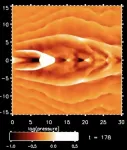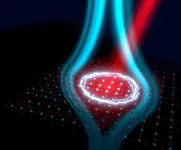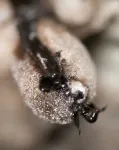(Press-News.org) Galaxies avoid an early death because they have a "heart and lungs" which effectively regulate their "breathing" and prevent them growing out of control, a new study suggests.
If they didn't, the Universe would have aged much faster than it has and all we would see today is huge "zombie" galaxies teeming with dead and dying stars.
That’s according to a new study published in the Monthly Notices of the Royal Astronomical Society, which investigates one of the great mysteries of the Universe – why galaxies are not as large as astronomers would expect.
Something appears to be stifling their enormous potential by limiting the amount of gas they absorb to convert into stars, meaning that instead of endlessly growing, something inside resists what was thought to be the inevitable pull of gravity.
Now, astrophysicists at the University of Kent think they may have uncovered the secret. They suggest that galaxies could in fact control the rate at which they grow through how they "breathe".
In their analogy, the researchers compared the supermassive black hole at the centre of a galaxy to its heart and the two bi-polar supersonic jets of gas and radiation they emit to airways feeding a pair of lungs.
Pulses from the black hole - or "heart" - can lead to jet shock fronts oscillating back and forth along both jet axes, much like the thoracic diaphragm in the human body moves up and down inside a chest cavity to inflate and deflate both lungs.
This can result in jet energy being transmitted widely into the surrounding medium, just as we breathe out warm air, resulting in slowing galaxy gas-accretion and growth.
PhD student Carl Richards came up with the theory after creating new, never-before-tried simulations to investigate the role supersonic jets might play in inhibiting galaxy growth.
These involved allowing the black hole "heart" to pulse and the jets to be at high pressure – much like a form of hypertension, if extending the comparison to the human body.
This caused the jets to "act like bellows", he said, by sending out sound waves "like ripples on a pond surface".
The phenomena is similar to the terrestrial equivalent of sound and shock waves being produced when opening a bottle of champagne, the screech of a car, rocket exhausts and the puncture of pressurised enclosures.
"We realised that there would have to be some means for the jets to support the body - the galaxy’s surrounding ambient gas - and that is what we discovered in our computer simulations," Richards said.
"The unexpected behaviour was revealed when we analysed the computer simulations of high pressure and allowed the heart to pulse.
"This sent a stream of pulses into the high-pressure jets, causing them to change shape as a result of the bellows-like action of the oscillating jet shock fronts."
These overpressured jets effectively expanded "like air-filled lungs", the researchers said.
In doing so, they transmitted sound waves into the surrounding galaxy in the form of a series of pressure ripples, which were then shown to suppress the galaxy's growth.
There is some evidence of ripples in extra-galactic media, such as those observed in the nearby Perseus galaxy cluster associated with enormous hot gas bubbles, which are believed to be examples of sound waves.
These ripples were already thought to be responsible for sustaining the ambient environment surrounding a galaxy, although a mechanism to generate them was missing.
Conventional cosmological simulations are therefore unable to account for the flows of gas into galaxies, leading to one of the great mysteries of the Universe, so it relies on the highly-active black hole at a galaxy's heart to provide some resistance.
"To do this is not easy, however, and we have constraints on the type of pulsation, the size of the black hole and the quality of the lungs," said co-author Professor Michael Smith.
"Breathing too fast or too slow will not provide the life-giving tremors needed to maintain the galaxy medium and, at the same time, keep the heart supplied with fuel."
The researchers concluded that a galaxy's lifespan can be extended with the help of its "heart and lungs", where the supermassive black hole engine at its core helps inhibit growth by limiting the amount of gas collapsing into stars from an early stage.
This, they say, has helped create the galaxies we see today.
Without such a mechanism, galaxies would have exhausted their fuel by now and fizzled out, as some do in the form of "red and dead" or "zombie" galaxies.
The paper ‘Simulations of Pulsed Overpressure Jets: Formation of Bellows and Ripples in Galactic Environments’, Carl Richards and Michael Smith, has been published in Monthly Notices of the Royal Astronomical Society.
Media contacts
Sam Tonkin
Royal Astronomical Society
Mob: +44 (0)7802 877700
press@ras.ac.uk
Robert Massey
Royal Astronomical Society
Mob: +44 (0)7802 877699
press@ras.ac.uk
Science contacts
Carl Richards
University of Kent
cr704@kent.ac.uk
Mob: +44 (0)7754 674003
Professor Michael Smith
University of Kent
m.d.smith@kent.ac.uk
Tel: +44 (0)1227 365413
Images and video
Simulation of a galaxy’s ‘heart and lungs’ at work
Caption: This clip shows a supersonic jet generating a "bellows-like action", by receiving pulses from its black hole "heart", causing it to expand and contract "like an air-filled lung", "breathing out warm air" (pressure ripples) into its surroundings. The graph axes are non-dimensional distance scales.
Credit: C Richards/MD Smith/University of Kent
Symmetric bi-polar galaxy jets
Caption: An artist's impression showing bi-polar jets of gas originating from a supermassive black hole at the centre of a galaxy.
Credit: ESA/Hubble, L. Calçada (ESO)
Pulses travelling along galaxy jets
Caption: Two different examples of the simulation of one side of symmetric bi-polar jets, where pressure ripples spread out across the extra-galactic medium. Shown here are pressure variations using a red-temperature colour scale (dark=low pressure, light=high pressure). Each jet enters from the left with a pressure that rapidly falls as it pushes against the ambient medium. The axes are non-dimensional distance scales.
Credit: C Richards/MD Smith/University of Kent
Illustration of Ripples in Perseus
Caption: The sound waves (ripples) in the hot gas that fills the Perseus cluster are shown in this artist's impression. They are thought to have been generated by cavities blown out by jets from a supermassive black hole (bright white spot) at the centre of the galaxy.
Credit: NASA/NASA/CXC/M.Weiss
Further information
The new study ‘Simulations of Pulsed Overpressure Jets: Formation of Bellows and Ripples in Galactic Environments’, Carl Richards and Michael Smith, has been published in Monthly Notices of the Royal Astronomical Society.
It will be available here when the embargo lifts. To request a copy of the paper, email press@ras.ac.uk.
Notes for editors
About the Royal Astronomical Society
The Royal Astronomical Society (RAS), founded in 1820, encourages and promotes the study of astronomy, solar-system science, geophysics and closely related branches of science.
The RAS organises scientific meetings, publishes international research and review journals, recognises outstanding achievements by the award of medals and prizes, maintains an extensive library, supports education through grants and outreach activities and represents UK astronomy nationally and internationally. Its more than 4,000 members (Fellows), a third based overseas, include scientific researchers in universities, observatories and laboratories as well as historians of astronomy and others.
The RAS accepts papers for its journals based on the principle of peer review, in which fellow experts on the editorial boards accept the paper as worth considering. The Society issues press releases based on a similar principle, but the organisations and scientists concerned have overall responsibility for their content.
Keep up with the RAS on X, Facebook, LinkedIn and YouTube.
END
How the 'heart and lungs' of a galaxy extend its life
2024-07-12
ELSE PRESS RELEASES FROM THIS DATE:
Light-induced Meissner effect in optically driven YBa2Cu3O6.48
2024-07-12
Superconductivity is a fascinating phenomenon, which allows a material to sustain an electrical current without any loss. This collective quantum behavior of matter only appears in certain conductors at temperatures far below ambient.
A number of modern studies have investigated this behavior in so-called non-equilibrium states, that is in situations in which the material is pushed away from thermal equilibrium. In these conditions, it appears that at least some of the features of superconductivity can be recreated even at ambient temperatures. Such non-equilibrium high temperature superconductivity, shown to exist under irradiation ...
Study finds short and long sleep duration associated with blood vessel damage in those recently diagnosed with type 2 diabetes
2024-07-12
New research to be presented at this year’s Annual Meeting of the European Association for the Study of Diabetes (EASD) (Madrid, 9-13 September) shows that people recently diagnosed with diabetes who experience short or long sleep duration are more likely to experience microvascular disease (damage to the small blood vessels), which could ultimately lead to more serious complications. The study is by Mette Johansen and Thomas Olesen, Steno Diabetes Center Odense, Odense University Hospital, Odense, Denmark, and colleagues.
Microvascular complications, such as retinopathy and nephropathy, are major contributors ...
IoT sensors tattle on stores that neglect promo displays
2024-07-11
Whether it’s a pharmacy, a supermarket, or a clothier, when you walk into a retail store in the U.S., you are sure to encounter a flashy promotional display featuring products from a specific brand.
It’s a marketing strategy that’s been proved to be highly effective at boosting sales. Brands carefully plan display campaigns, signing contracts with retailers that specify when to install the exhibits and for how long. They often provide financial incentives to encourage compliance.
But a new study from Ashish ...
A stealth fungus has decimated North American bats but scientists may be a step closer to treating white-nose syndrome
2024-07-11
An invasive fungus that colonizes the skin of hibernating bats with deadly consequences is a stealthy invader that uses multiple strategies to slip into the small mammals' skin cells and quietly manipulate them to aid its own survival. The fungus, which causes the disease white-nose syndrome, has devastated several North American species over the last 18 years.
Scientists have learned much about the fungus, Pseudogymnoascus destructans, since it was first documented in a New York cave in 2006, including where it thrives, its distribution, and clinical features. But exactly ...
Menstrual cramps can be worse in normal-length cycles without ovulation
2024-07-11
According to current understanding, menstrual cramps only happen in cycles in which an egg is released, or an ovulatory cycle. But new research from the University of British Columbia (UBC) is challenging this notion.
The findings, published in the Journal of Pain Research, reveal that some women not only experience cramps when no egg is released, but that cramps can be more severe and last longer during these anovulatory cycles.
“I was surprised to see significant cramps in menstrual cycles with or without ovulation, which challenges current thinking” said co-author, Dr. Paul Yong, associate professor of obstetrics and gynecology at UBC and Canada Research ...
Racial disparities in dementia determined by social factors
2024-07-11
Racial disparities in dementia are due to social determinants of health, with genetic ancestry playing no role, according to a new study led by researchers at Washington University School of Medicine in St. Louis.
The study, which was based on a long-running population-based survey in four Latin American countries, helps explain why people of predominantly Native American or African ancestry have a higher prevalence of dementia: Study participants were more likely to experience social contexts and health conditions that raised their risk of cognitive decline, such as lower education levels, rural residency and high blood pressure. Once such factors ...
Rice engineers’ probe could help advance treatment for spinal cord disease, injury
2024-07-11
HOUSTON – (July 11, 2024) – Implantable technologies have significantly improved our ability to study and even modulate the activity of neurons in the brain, but neurons in the spinal cord are harder to study in action.
“If we understood exactly how neurons in the spinal cord process sensation and control movement, we could develop better treatments for spinal cord disease and injury,” said Yu Wu, a research scientist who is part of a team of Rice University neuroengineers working on a solution to this problem.
“We developed a tiny sensor, spinalNET, that records the electrical activity of spinal neurons as the subject performs normal ...
Muscle machine: How water controls the speed of muscle contraction
2024-07-11
Image
The flow of water within a muscle fiber may dictate how quickly muscle can contract, according to a University of Michigan study.
Nearly all animals use muscle to move, and it's been known for a long time that muscle, like all other cells, is composed of about 70% water. But researchers don't know what sets the range and upper limits of muscle performance. Previous research into how muscle works focused only on how it worked on a molecular level rather than how muscle fibers are shaped, that they are three-dimensional ...
Nearly one in 10 pregnant people who get COVID will develop long COVID
2024-07-11
Nearly one in 10 people who get COVID while pregnant will go on to develop long COVID, a report publishing July 11th in Obstetrics & Gynecology has found.
“It was surprising to me that the prevalence was that high,” says Torri Metz, MD, vice chair of research of obstetrics and gynecology at University of Utah Health, who co-led the nationwide study. “This is something that does continue to affect otherwise reasonably healthy and young populations.”
Intersecting risks
Prior research had shown that COVID affects pregnant people in uniquely ...
User control of autoplay can alter awareness of online video ‘rabbit holes’
2024-07-11
UNIVERSITY PARK, Pa. — The rabbit hole contains madness, according to author Lewis Carroll. Online, that madness manifests in the form of increasingly extreme content, often without users realizing it. A new study by Penn State researchers suggests that giving users control over the interface feature of autoplay can help them realize that they are going down a rabbit hole.
The work — which the researchers said has implications for responsibly designing online content viewing platforms and algorithms, as well as helping users better ...








